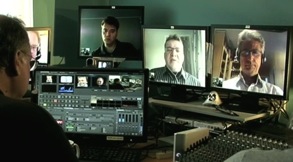 We’ve only got a few days to go before Steve Jobs tells us what we’re spending our money on this year. From all the leaks and positioning announcements, it appears we’re being pushed into the Pay Zone. The NY Times, the top four or five TV shows, the embargo-free bestseller. The bet is we’ll pay for same-day-as access to discretionary consumption of media. I think he’s right. But is that as big a bang as the iPhone?
We’ve only got a few days to go before Steve Jobs tells us what we’re spending our money on this year. From all the leaks and positioning announcements, it appears we’re being pushed into the Pay Zone. The NY Times, the top four or five TV shows, the embargo-free bestseller. The bet is we’ll pay for same-day-as access to discretionary consumption of media. I think he’s right. But is that as big a bang as the iPhone?
In and of itself, the tApplet does not change the world or even our corner of the world. But just as with the disruption triggered by the iPhone, this new disruption will move beyond the carriers and into the center of the creative core of the netertainment and information industries. In turn, this new wave of video, music, and text will quickly overturn some of the major stakeholders and rewrite how we spend our time at work and play.
It’s hard to think far enough back to remember how we used to use our computer time before realtime stole onto the stage. Back before my MacBook Air, which turned every other computer in the place into an appliance: the MacBook Pro for rendering video, the iMac for Web site design, the PC for nothing. Back when software was something I paid for, music something I shopped for, television something I set a timer for.
The MacBook Air’s disruption was the strategic removal of an internal CD/DVD drive. It declared independence from physical media, and bootstrapped existing devices to serve as feed machines for the rare need to rip a CD or backup a file for sneakernet. USB drives quickly eliminated even that requirement, and the move to cloud services sealed the deal.
Streaming media rushed quickly into the vacuum of tangible media. Once the location of the actual bits was made irrelevant by look-ahead caching, we quickly learned to validate those services which allowed us to share pointers to the material rather than the downloadable enclosures. Identity online became the control point for micropayments, and the incentive for providing behavior and social signals in return for discounts and sponsored bundling. WiFi became the razor, and the streams the blades.
In effect, we are now selling our gestures into the stream hoping to build up enough credit to buy these new devices as they reach the intersection of battery life, broadband, and social filtering. The overt and implicit affinity groups are the nodes in this realtime auction, harvesting the most elegant and intuitive of their tribe to finance access to the streams most relevant and informative of the next day’s work. Like dreams, these affinity surges work through the underlying themes, fears, yearning, and hopes we share.
Literally, what this means is a renaissance of the kind felt in the Sixties, when music, film, and political discourse conspired in a furnace of creativity. Today these devices are mere portals into this next wave, important only because of what they help to make possible. The iPhone’s genius was in combining the elements to produce a device capable of accelerating use of the network in realtime, to signal the arrival, the existence, of valuable things. Virtualized, homogenized into streams, predicatively cached to preserve the illusion of stability, voice activated to teach the network who we are.
Google has emerged as a great validator not just of the cloud model but the inspiration of the Jobs model: that we can imagine our way into the future we can only glimpse at any given moment. With the iPhone it was brain dead obvious that if the idea could be instantiated, the economic forces could be harnessed to improve the experience as more desired it. The more Apple and Google and Amazon succeed, the more they need to compete with their own success to survive and prosper.
Three machines: the Kindle, the Nexus One, the Apple tablet. Each offers something essential to the power of the creatives who will fuel this disruption. The Kindle is simple, cheap, battery frugal. The Nexus One is multi-tasking, cloud-fueled, realtime empowered. The Apple machine bridges the media across the digital shoals, most likely straddling the intersection of the creative arts now floundering in late night wars, 360 deals, and the great archives we’ve lost the right to share. These are the pre-existing conditions, just before another Golden Age is upon us.
The Gillmor Gang — Andrew Keen, Doc Searls, Robert Scoble, Sam Whitmore, Dan Farber, and Kevin Marks — on the Tablet Wars. Recorded live, Friday, January 22, 2010.